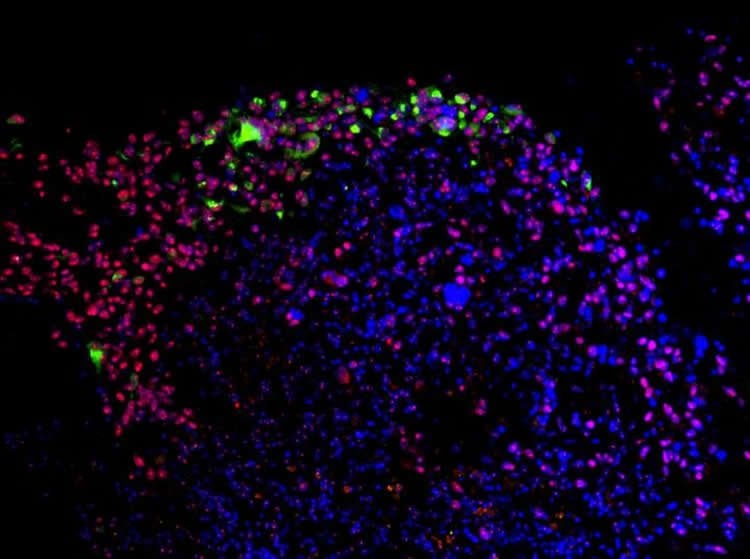Summary: A new study in the Journal of Experimental Medicine report Zika virus could be used to target and treat glioblastoma brain cancer. Researchers found a mouse adapted strain of Zika slowed tumor growth and extended life span in mice with glioblastoma.
Source: Rockefeller University Press.
Recent outbreaks of Zika virus have revealed that the virus causes brain defects in unborn children. But in a study to be published September 5 in The Journal of Experimental Medicine, researchers from Washington University School of Medicine in St. Louis and the University of California, San Diego report that the virus could eventually be used to target and kill cancer cells in the brain.
Glioblastoma is the most common form of brain cancer and is frequently lethal; most patients die within two years of diagnosis. Just like normal, healthy tissues, the growth and development of glioblastomas is driven by stem cells that proliferate and give rise to other tumor cells. Glioblastoma stem cells are hard to kill because they can avoid the body’s immune system and are resistant to chemotherapy and radiation. But killing these cells is vital to prevent new tumors from recurring after the original tumor has been surgically removed.
“It is so frustrating to treat a patient as aggressively as we know how, only to see his or her tumor recur a few months later. We wondered whether nature could provide a weapon to target the cells most likely responsible for this return,” says Milan Chheda from Washington University School of Medicine in St. Louis.
One approach to killing cancer stem cells involves using viruses that specifically target tumor cells. Zika virus appears to disrupt fetal brain development by preferentially targeting neural stem and progenitor cells. The virus’ effects on adult brains–which contain fewer active stem cells that developing fetal brains–are generally much less severe.
“We hypothesized that the preference of Zika virus for neural precursor cells could be leveraged against glioblastoma stem cells,” says Michael Diamond, also from Washington University School of Medicine in St. Louis, who co-directed the study with Milan Chheda and with Jeremy Rich, from the University of California, San Diego and the Cleveland Clinic Lerner Research Institute.
The researchers found that Zika virus preferentially infected and killed patient-derived glioblastoma stem cells compared with other glioblastoma cell types or normal neural cells. When mice with aggressive glioma were injected with a mouse-adapted strain of Zika virus, the virus slowed tumor growth and significantly extended the animals’ lifespan.
The researchers then tested a mutant strain of Zika that is less virulent than naturally occurring strains of the virus. This “attenuated” strain, which is more sensitive to the body’s immune response, was still able to specifically target and kill glioblastoma stem cells and was even more effective when combined with a chemotherapy drug, temozolomide, that usually has little effect on these cells. “This effort represents the creative synthesis of three research groups with complementary expertise to attack a deadly cancer by harnessing the cause of another disease,” says Jeremy Rich. “Adults with Zika may suffer less damage from their infection, suggesting that this approach could be used with acceptable toxicity.”

“Our study is a first step towards the development of safe and effective strains of Zika virus that could become important tools in neuro-oncology and the treatment of glioblastoma,” says Diamond. “However, public health concerns will need to be addressed through pre-clinical testing and evaluations of the strains’ ability to disseminate or revert to more virulent forms.”
Funding: Funding provided by National Institutes of Health, Elsa U. Pardee Foundation, Concern Foundation, Cancer Research Foundation, Mc-Donnell Center for Cellular and Molecular Neurobiology of Washington University.
Source: Rory Williams – Rockefeller University Press
Image Source: NeuroscienceNews.com image is credited to Zhu et al., 2017.
Original Research: Full open access research for “Zika virus has oncolytic activity against glioblastoma stem cells” by Zhe Zhu, Matthew J. Gorman, Lisa D. McKenzie, Jiani N. Chai, Christopher G. Hubert, Briana C. Prager, Estefania Fernandez, Justin M. Richner, Rong Zhang, Chao Shan, Xiuxing Wang, Pei-Yong Shi, Michael S. Diamond, Jeremy N. Rich, and Milan G. Chheda in Journal of Experimental Medicine. Published online September 5 2017 doi:10.1084/jem.20171093
[cbtabs][cbtab title=”MLA”]Rockefeller University Press “Zika Virus Could Be Used to Treat Brain Cancer Patients.” NeuroscienceNews. NeuroscienceNews, 5 September 2017.
<https://neurosciencenews.com/zika-brain-cancer-7413/>.[/cbtab][cbtab title=”APA”]Rockefeller University Press (2017, September 5). Zika Virus Could Be Used to Treat Brain Cancer Patients. NeuroscienceNew. Retrieved September 5, 2017 from https://neurosciencenews.com/zika-brain-cancer-7413/[/cbtab][cbtab title=”Chicago”]Rockefeller University Press “Zika Virus Could Be Used to Treat Brain Cancer Patients.” https://neurosciencenews.com/zika-brain-cancer-7413/ (accessed September 5, 2017).[/cbtab][/cbtabs]
Abstract
Zika virus has oncolytic activity against glioblastoma stem cells
Glioblastoma is a highly lethal brain cancer that frequently recurs in proximity to the original resection cavity. We explored the use of oncolytic virus therapy against glioblastoma with Zika virus (ZIKV), a flavivirus that induces cell death and differentiation of neural precursor cells in the developing fetus. ZIKV preferentially infected and killed glioblastoma stem cells (GSCs) relative to differentiated tumor progeny or normal neuronal cells. The effects against GSCs were not a general property of neurotropic flaviviruses, as West Nile virus indiscriminately killed both tumor and normal neural cells. ZIKV potently depleted patient-derived GSCs grown in culture and in organoids. Moreover, mice with glioblastoma survived substantially longer and at greater rates when the tumor was inoculated with a mouse-adapted strain of ZIKV. Our results suggest that ZIKV is an oncolytic virus that can preferentially target GSCs; thus, genetically modified strains that further optimize safety could have therapeutic efficacy for adult glioblastoma patients.
“Zika virus has oncolytic activity against glioblastoma stem cells” by Zhe Zhu, Matthew J. Gorman, Lisa D. McKenzie, Jiani N. Chai, Christopher G. Hubert, Briana C. Prager, Estefania Fernandez, Justin M. Richner, Rong Zhang, Chao Shan, Xiuxing Wang, Pei-Yong Shi, Michael S. Diamond, Jeremy N. Rich, and Milan G. Chheda in Journal of Experimental Medicine. Published online September 5 2017 doi:10.1084/jem.20171093






